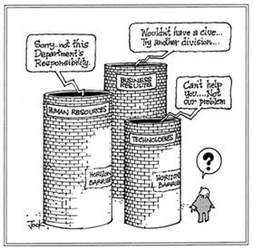 Every time we talk about operationalizing whole lifecycle asset management there is a term that is constantly referred to – organizational silos. It sounds like it is a common problem in many organizations when it comes to implementing a holistic asset management philosophy. So what are organizational silos? Are they really a problem? How do we overcome them? In one of my previous blogs when I talked about theory of constraints I mentioned that ‘organizational silos’ is indeed a constraint. In my book I dedicated a full page (it should have been more, now that I think of it) on organizational silos. So what are they and are they really that bad? In many literature and articles there is mention of breaking down those silos or even of shattering them. But how do we do that and will that resolve the issue on hand? Before talking about breaking silos down or shattering them, we should understand why they actually exist in the first place. They are obviously not a natural occurrence. They were created on purpose as a form of management style via organizational structures and specialized job designs to segregate the various governance mechanisms into functional enclaves, where technical specialist work independently of the other functions. However what ended up happening is that organizations get caught in a functional silo syndrome where there is a lack of mutual concern and cohesion. Individuals ingenuity is wasted, groups are not collaborating and there is no shared vision for people to rally around. Gillian Tett put it brilliantly in her book, The Silo Effect: “Silos can be useful but also dangerous. They have the power to collapse companies and destabilize financial markets, yet they still dominate the workplace. They blind and confuse us, often making modern institutions collectively act in risky, silly, and even stupid ways.” The functional enclaves (e.g. finance, operations, maintenance, project management, marketing, etc.) should consider how the techniques that they develop within their own function might work together with the other functions. It would also be helpful if they consider how they jointly might be able to develop better ways to balance conflicting objectives to meet the organizational strategic goals. Can you recognize the functional silo(s) in your organization? Can you recognize the silo effects prevailing? Can you think of ways to overcome those silo effects? Posted by Dharmen Dhaliah
12 Comments
5/6/2019 08:30:17 pm
An organization cannot function if the cogs are not properly managed. Well, when I say cogs, I mean the people in the organizations. An organization's success is heavily reliant on the people inside them. No matter what the organization achieved, it is not something that can be accomplished in an individual effort. An organization works as a unit, as a team, as a group of individuals. I hope that we understand this very fact right here, it would help us.
Reply
9/27/2023 03:36:24 am
Online money-making requires adapting to changing trends and technologies in the digital landscape.
Reply
9/30/2023 06:58:05 am
Reviewing business contracts with an attorney can prevent future disputes and legal complications.
Reply
10/2/2023 11:52:33 am
I'm passionate about sharing resources and tips for seamless wellness because I believe that knowledge is power.
Reply
10/6/2023 03:33:51 am
Motivational speakers equip workers with the mindset and tools to thrive in a competitive world.
Reply
10/9/2023 01:35:24 am
Trained healthcare professionals Melbourne are instrumental in ensuring that residents receive timely and effective medical care.
Reply
10/9/2023 06:57:30 am
The ability of pet doctors to accurately diagnose and treat a wide range of medical conditions is a testament to their extensive training and experience.
Reply
10/14/2023 02:05:29 am
Gambling operators often implement responsible gaming measures, including self-exclusion programs, to help individuals limit their gambling activities.
Reply
11/17/2023 01:12:42 am
Enter the virtual arena: Where legends are born and epic tales unfold!
Reply
Leave a Reply. |
FollowAuthorDharmen Dhaliah, P.Eng, MBA, PMP, CAMA, MMP, CMRP Archives
October 2021
Categories |

 RSS Feed
RSS Feed